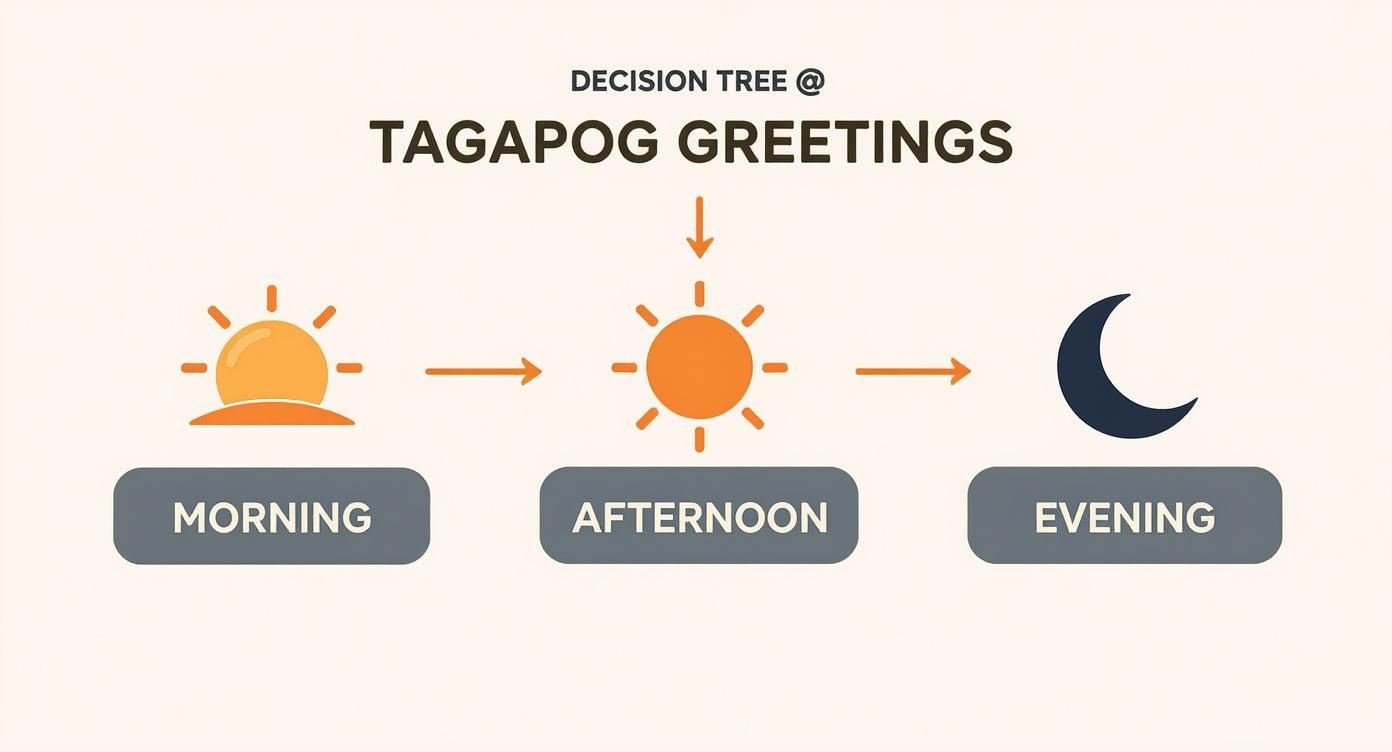Your Guide to Saying Hello in Tagalog
If you're looking for the simplest, most common way to say hello in Tagalog, your go-to word is Kamusta. It’s the perfect all-rounder for any situation.
Think of it less as a direct translation of "hello" and more like the friendly English question, "How are you?" It opens up a conversation and shows you’re interested in the other person.
Your Quick Guide to Filipino Greetings
Getting the pronunciation right is key to sounding natural. For Kamusta, just say it like this: Ka-moos-TAH, with the emphasis on that last syllable.
While Kamusta works anytime, you can show a bit more cultural flair by greeting people based on the time of day. It's a small touch, but it’s a warmer, more polite way to start a chat, whether you’re travelling in the Philippines or just talking with Filipino friends.
Tagalog, which is officially known as Filipino in its standardised form, is a major language with a huge global footprint. It's spoken by 28 to 33 million native speakers and another 50 million as a second language. Here in Singapore, it’s a cornerstone of the vibrant local Filipino community. You can get a better sense of the global reach of the Tagalog language and its speakers online.
Essential Tagalog Greetings at a Glance
To help you get started, here's a simple table with the greetings you'll use most often. Mastering these will cover almost any social situation you'll encounter.
| Tagalog Greeting | English Translation | When to Use |
|---|---|---|
| Kamusta | How are you? | Any time of day, informal or formal |
| Magandang umaga | Good morning | From sunrise until noon |
| Magandang hapon | Good afternoon | From noon until sunset |
| Magandang gabi | Good evening/night | After sunset |
Keep this little guide handy, and you'll be greeting people like a local in no time. It's all about making that friendly connection, and these phrases are the perfect way to do it.
Mastering Kamusta: The Universal Filipino Greeting
If you're looking for a direct, one-word translation of "hello" in Tagalog, you might be surprised to learn there isn't one. Instead, the go-to greeting that works in nearly every situation is Kamusta.
Think of it as the friendly, all-purpose starting point for any Filipino conversation. It's incredibly versatile because it packs a double meaning: it serves as both "hello" and "how are you?" all in one simple, warm word.
This isn't just a happy accident of language. The word itself tells a story, tracing back to the Spanish phrase “¿Cómo está?” ("How are you?"). This little piece of history is a direct result of over 300 years of Spanish influence in the Philippines, and its evolution into Kamusta really captures the relational heart of Filipino culture.
When you ask someone "Kamusta?", you're doing more than just saying hi. You're opening the door for a real connection.
How to Say Kamusta Correctly
Nailing the pronunciation of Kamusta will make you sound instantly more natural and warm. The most important thing to remember is to put the emphasis on the last syllable.
Let's break it down:
- Ka – A short, crisp sound, like the 'ca' in 'cat'.
- moos – This part rhymes with 'goose'.
- TAH – This is the final syllable, and it gets all the stress. Make it strong and clear.
So, all together, it flows as Ka-moos-TAH. Say it out loud a few times to feel the rhythm. Getting this right is a fantastic way to break the ice and show that you're making a genuine effort.
Adapting Kamusta for Any Situation
Just as you'd speak differently to your best friend than you would to a respected elder, Kamusta can be tweaked to fit the social setting. While the core word stays the same, adding a little something extra can change the level of formality.
For friends, family, or anyone your age, a simple “Kamusta ka?” is perfect. This literally means "How are you?", where ka is the informal, singular form of "you".
When you find yourself in a more formal setting—like meeting your partner's parents or speaking with a boss—you'll want to dial up the politeness. We'll soon get into how adding words like po and kayo can transform this simple greeting, showing a deeper level of respect.
While Kamusta is your go-to, all-purpose greeting, you can really show you've done your homework by greeting people according to the time of day. This is a common and genuinely appreciated custom in the Philippines. Think of it as the difference between a simple "hello" and a more thoughtful "good morning" – it just adds a nice layer of warmth to the conversation.
At the heart of these greetings is a truly lovely word: Maganda. Pronounced ma-gan-DA, it literally means "beautiful." So, when you're wishing someone a good morning, you're actually wishing them a "beautiful morning." It’s a small touch, but this poetic structure turns a standard greeting into a heartfelt wish.
Morning, Afternoon, and Evening Greetings
Figuring out when to use each phrase is pretty intuitive, as it just follows the flow of the day. As the hours tick by, you can switch from one to the next to make your greetings feel more natural and in tune with local customs.
Here’s a quick guide to get you started:
- Magandang umaga (ma-gan-DANG oo-MA-ga): This is your "Good morning." It's perfect for any time from sunrise until noon. Use it when you're grabbing your morning coffee or for any early encounters.
- Magandang hapon (ma-gan-DANG HA-pon): This means "Good afternoon." You’ll want to start using this from noon until the sun starts to dip, usually around 5 or 6 PM.
- Magandang gabi (ma-gan-DANG ga-BI): Your "Good evening" or "Good night." This one is for any time after sunset and for the rest of the night.
Key Takeaway: Using time-specific greetings is a fantastic way to level up how you say hello in Tagalog. It shows you're moving beyond the basics and making a real effort to connect with Filipino culture.
This thoughtful approach to language is something you’ll see in Filipino communities all over the world. For example, in Singapore, home to a Filipino community of around 180,000, there's a real passion for keeping cultural and language traditions alive. Studies have shown a strong desire to preserve Tagalog, highlighting its role in cultural identity, even for those living abroad. You can discover more insights about Tagalog language statistics and its global footprint.
Greeting with Respect: Formal vs. Informal Tagalog
In Filipino culture, respect isn't just a concept; it's built right into the language. This is especially true when you're talking to elders, people in positions of authority, or even someone you've just met. Getting this right is the difference between simply knowing the words and truly connecting with people.
The magic ingredients for showing respect are two tiny, but powerful, words: po and opo. Think of them as instant politeness enhancers. Adding po to your sentences or using opo (the respectful way to say "yes") immediately makes your Tagalog sound more courteous and thoughtful.
Formal vs Informal Greetings
Let's look at how this plays out with the greetings we've already covered. "Kamusta ka?" is your go-to for friends, family, and anyone your age. But if you're talking to an older person, you'll want to switch things up. The informal "ka" (you) becomes "kayo" (the formal or plural 'you'), and you add that all-important "po".
Kamusta ka? becomes Kamusta po kayo? This small change carries a lot of weight. It’s a clear signal that you understand and value Filipino social customs, which is always appreciated.
Choosing the right greeting really just depends on who you're speaking with. This handy chart helps you pick the right greeting for the time of day.
Once you've picked the right phrase from the chart, just add po to make it formal. "Magandang umaga" (Good morning) easily becomes "Magandang umaga po." Simple as that.
This emphasis on politeness isn't unique to the Philippines; it's a common thread in many Southeast Asian cultures. If you're exploring other languages in the region, you'll find similar cultural nuances in our guide on learning Bahasa Melayu.
To make it even clearer, here’s a quick-glance table to help you switch between casual and respectful greetings on the fly.
Formal vs Informal Tagalog Greetings
This table breaks down some common phrases to show how a simple "po" or "opo" can transform your greeting.
| Informal Greeting (for friends/peers) | Formal Greeting (with 'po'/'opo') | When to Use the Formal Version |
|---|---|---|
| Kamusta ka? | Kamusta po kayo? | Speaking to elders, bosses, teachers, or strangers. |
| Magandang umaga. | Magandang umaga po. | Greeting someone older or a superior in the morning. |
| Salamat. | Salamat po. | Thanking anyone you want to show an extra layer of respect to. |
Getting a handle on these differences takes your ability to say hello in Tagalog to a whole new level. It stops being about just translating words and becomes a genuine way to show cultural understanding and respect.
Keeping the Conversation Going After Hello
A warm greeting is your way in, but what you say next is what really opens the door to a genuine conversation. After you’ve exchanged a friendly “Kamusta,” you’ll want to be ready for the natural back-and-forth that follows.
When someone asks you, "Kamusta ka?" (How are you?), the standard, polite reply is "Mabuti naman, salamat." This simply means, "I'm doing well, thank you." It’s the perfect, all-purpose response for just about any situation.
Of course, any good chat is a two-way street. After you've answered, you’ll want to return the favour. A simple "Ikaw?" (And you?) works beautifully in casual chats. If you want to show a bit more respect, use "Kayo?" (And you? – formal).
A Quick Example:
Person A: "Magandang hapon! Kamusta ka?" (Good afternoon! How are you?)
Person B: "Mabuti naman, salamat. Ikaw?" (I'm doing well, thank you. You?)
Must-Know Phrases for Polite Conversation
Once you've got the greetings down, a few other polite words will become the backbone of your interactions. Getting these right will help you navigate your first Tagalog conversations with confidence.
Here are the absolute essentials:
- Salamat: This means "Thank you." To add a layer of respect, especially when talking to someone older, you can say "Salamat po."
- Pakiusap: This is the Tagalog word for "Please."
These simple phrases go a long way in showing courtesy. Even in diverse places like Singapore where English is a common bridge, making an effort to use a few words in someone's native language shows a great deal of respect. While many Filipinos speak English, studies on language attitudes show that Tagalog is still a cornerstone of cultural identity and everyday life. You can read more about the main languages of Singapore and their roles on Polilingua.com.
The best way to get comfortable is to practise. You could find a partner for a language exchange in Singapore to build up your skills. And as you get into longer conversations, learning how to translate audio can be a huge help in understanding the natural flow of spoken Tagalog. Putting it all together is how you move from just saying a basic hello in Tagalog to having your first real, polite exchange.
Common Questions About Tagalog Greetings
As you start dipping your toes into Tagalog, you'll probably run into a few common questions. It’s completely normal! Getting these sorted out early will give you a real confidence boost and make your conversations flow much more smoothly.
Let's break down some of the most frequent queries people have.
Is There a Direct Translation for "Hello"?
This is easily the number one question, and the short answer is no, there isn't a direct one-word translation for "hello."
The closest you'll get is Kamusta. It's a wonderfully versatile word that works as both a greeting and a way to ask "how are you?" In most other cases, Filipinos use time-based greetings like Magandang umaga (Good morning), which feel much more natural and culturally fitting.
This is a bit different from a language like Spanish, where Hola is a straightforward greeting. In Tagalog, the greeting is more about checking in on the other person. You can see this contrast in our guide on how to say "how are you" in Spanish.
What Is the Difference Between Kamusta and Kumusta?
You’ll definitely see both of these spellings around, and the great news is, they're both correct and everyone will understand you.
Kumusta is the more traditional spelling, hewing closely to its Spanish origin, ¿cómo está? On the other hand, Kamusta is the modern spelling that fits neatly with the standardised Filipino alphabet. You'll likely see Kamusta pop up more often in text messages and online.
Key Insight: Think of it like this: "Kamusta" is the everyday, modern spelling, while "Kumusta" is the classic version. Go with whichever one feels more natural to you—you can't go wrong.
How Do I Respond to "Kamusta Ka"?
So, what do you say when someone asks, "Kamusta ka?"
The perfect, polite response is, "Mabuti naman, salamat. Ikaw?" This means, "I'm fine, thank you. And you?" The word mabuti simply means "good" or "fine."
If you're in a more casual setting, a simple "Mabuti, salamat" (Fine, thanks) works just as well. The key is to always return the question—it's an essential part of the friendly exchange.
At Spanish Council Singapore, we believe that learning a language is about more than just vocabulary. It's about understanding these cultural nuances so you can communicate naturally and confidently in the real world.















